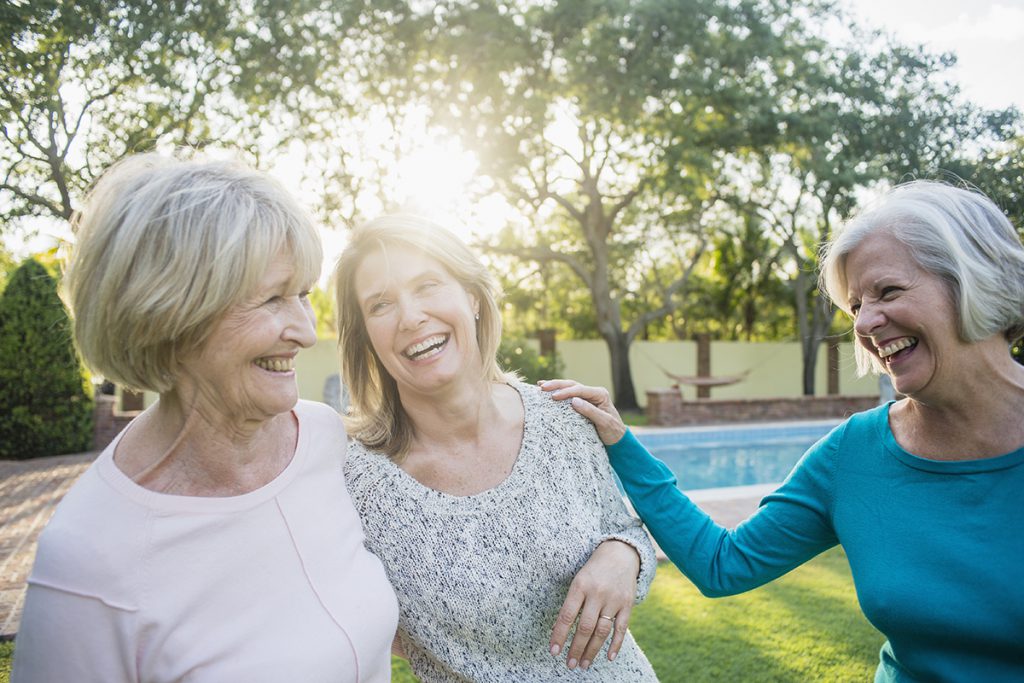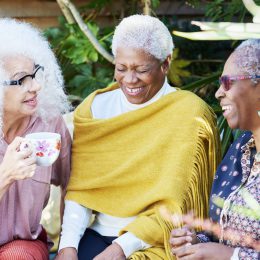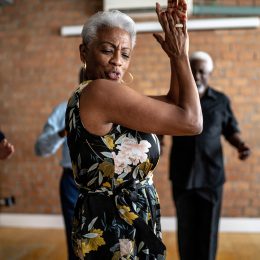Addressing Loneliness and Social Isolation: The SilverSneakers Guide
Chronic loneliness and isolation can lead to serious health issues, so here are the tools to get your mind and body back on track.

If you enjoy spending time alone, we totally get it. After all, there’s nothing quite like cozying into an armchair with a good book, watching whatever you want—for as long as you want—on streaming television, or daydreaming during a solo walk in the sunshine.
But spending too much time on your own does have some downsides, and that’s particularly true if it makes you feel lonely or isolated. Here’s how those two situations can have a ripple effect on your health, plus tips on building connections that help keep you mentally and physically healthy.
Emotional well-being and fitness go together! With SilverSneakers, you can attend dozens of different Community classes, visit a participating fitness location, or take part in SilverSneakers LIVE online classes. Check your eligibility here.
What are loneliness and social isolation?
According to the National Institute on Aging, loneliness is feeling separated or alone to the point of emotional distress. You can feel lonely when you’re on your own, but you can also feel lonely in the company of other people if you feel separated from them. (You can also be alone and never feel lonely.)
Social isolation is different than loneliness. It’s a lack of social contacts, meaning you don’t interact with many people on a regular basis — whether you wish you were socializing or not.
You, like so many others, may find yourself dealing with both issues at the same time. Research shows that humans are social animals and tend to function well in groups. Feeling left out or being alone most of the time can be difficult for many of us.
What causes social isolation in older adults?
More than a third of adults aged 45 and older report feeling lonely, according to a report from the National Academies of Sciences, Engineering, and Medicine. And a quarter of adults ages 65 and older are considered socially isolated.
People of any age can feel lonely and isolated, but as we grow older, it’s more common to spend time alone. That can be the result of circumstances such as:
- Children leaving home and moving further away
- Retirement
- Chronic health issues that reduce mobility
- Loss of a spouse or other family members
- Friends moving or passing away
- Changes in hearing and vision
- Memory loss or cognitive decline
The COVID-19 pandemic created another factor that led to social isolation: stay-at-home recommendations. When those were in place, people couldn’t spend time with friends and family who weren’t living in their own household. Meaning for many who live alone, a state of perpetual solitary confinement.
Even now, many people — especially those dealing with chronic illness — don’t socialize the way they once did.
Who is at higher risk for loneliness?
In some situations, loneliness is temporary, but for others, it becomes a chronic problem. If you’ve been sick and healing at home, for example, you may not see your friends for a few weeks, and you’ll likely feel a bit left out and lonesome. Other times, isolation may be long-term, which increases the chances that you’ll feel deeper loneliness.
You can be at greater risk if you:
- Are homebound due to illness, injury, or mobility issues
- Live alone
- Had a major loss, such as the death of a spouse or partner
- Lack financial security
- Reside in a rural or unsafe neighborhood
- Have limited social support
- Experience hearing or vision issues
- Have language barriers
- Feel a lack of purpose
- Face age, racial, ethnic, sexual orientation, or gender identity discrimination
- Are a caregiver, particularly for someone who is homebound
The more risk factors you have, the more likely you are to feel lonely. Knowing the signs of loneliness can help you determine if your feelings of isolation are becoming a problem.
What are the signs of loneliness?
The most common indicator of loneliness is feeling sad, but it’s certainly not the only one. Sometimes the signs are more subtle. Keep an eye out for these symptoms:
- A change in appetite, either a disinterest in eating or overeating
- Anger, irritability, resentment, and negative thoughts
- Sleep issues like insomnia, sleep disruption, or staying in bed when you’re not tired
- Paying less attention to personal hygiene
- Increased spending habits
- Excessive showers and baths, since research shows there’s a link between physical warmth and social connections
In general, consider whether there’s been a change in your self-care routine or enthusiasm for activities. Loneliness can often manifest as indifference or apathy.
Recommended reading: 5 Myths About Loneliness, Debunked
How do isolation and loneliness affect health?
Research shows that loneliness and isolation can have major effects on your mental and physical health. Loneliness is associated with a 32 percent increased risk of stroke and a 50 percent increased risk of developing dementia, according to the Centers for Disease Control (CDC).
Social isolation also puts you at higher risk for:
- Heart disease
- High blood pressure
- Obesity
- Depression and anxiety
- Lowered immune response
- Longer hospital stays
- Readmission to the hospital
- A shorter life span
Unfortunately, some of this is a vicious cycle: Loneliness can contribute to disease, but disease can also lead to loneliness. This is especially true if a chronic condition keeps you isolated at home, away from friends and loved ones who can help keep you company.
And there are other health pitfalls too: People who feel lonely or socially isolated also tend to get less exercise than those who are social. Lonely people often don’t sleep well, may drink more alcohol, or smoke cigarettes to help pass the time. All these unhealthy habits can further increase the risk of serious health problems.
Are loneliness and chronic pain connected?
Indeed, they are. Research shows that emotional pain can activate the same stress responses in the body as physical injury.
Subscribe to our newsletter
It's quick and easy. You could be one of the 13 million people who are eligible.
Already a member? Click to discover our 15,000+ participating locations.
Follow Us
When you feel lonely, your body produces more of the stress hormone, cortisol. Cortisol can raise inflammation levels, which makes you more sensitive to pain signals. When this continues over time, your pain response may become heightened, which means you feel more pain than you would if you weren’t lonely.
But there is some good news here: You have the power to combat this. By bolstering your social connections and dealing with loneliness, you can significantly reduce chronic pain. You’ll also lower the risk for other health problems and find more enjoyment in your day-to-day life.
How can I reduce feelings of loneliness?
There are lots of fun and exciting ways to strengthen your existing social connections and make new ones:
- Revisit a hobby you once enjoyed
- Take a SilverSneakers class to get moving
- Schedule calls with friends and family so they happen
- Drop in on a neighbor
- Write emails and send letters and cards
- Play an online game that lets you chat with others, such as Words With Friends
- Explore new technology like video chats and social media accounts
- Volunteer for a cause that’s close to your heart
- Look into resources and programs at your local library or senior center
- Start or join a walking or hiking club
- Foster or adopt a pet, since research shows senior pet owners tend to be less lonely
- Consider in-home caregivers if you have mobility issues or transportation problems
You might also start thinking about if it’s time to move into a senior-living community. There’s a wide range of them in terms of the type of housing, activities, and medical assistance they offer. Many even offer transportation to stores, entertainment, and restaurants. It’s wise to think about this possibility well before you need it, since some facilities have long waiting lists.
Recommended reading:
5 Ways to Strengthen Your Social Connections
SilverSneakers Community: 6 Reasons to Get Involved
How to Make a Friend: A 4-Step Plan
When should I talk to a doctor about isolation and loneliness?
As soon as you start seeing this may be an issue for you. Your conversations with your doctor should encompass all aspects of your well-being, and that includes mental health. In some cases, your doctor may refer you to a mental health professional, such as a therapist.
Your doctor can also help you with the root causes of your loneliness. For example, if you don’t like going out because you have hearing issues or mobility issues, your health team can help address and treat those concerns.
Take Your Favorite SilverSneakers Classes Online!
SilverSneakers members can access live fitness classes and wellness workshops through SilverSneakers LIVE. See the latest schedule and RSVP for classes here.
Not a member? If you have a Medicare Plan, it may include SilverSneakers—at no additional cost. Check your eligibility instantly here.
Not eligible for SilverSneakers? You can still get 200+ free SilverSneakers On-Demand videos and stay in touch with us by creating your online account.





